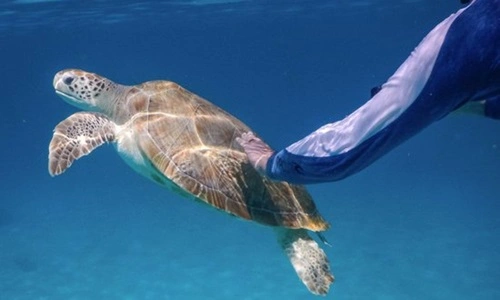Yes, it is illegal to touch sea turtles in the United States. Sea turtles are protected under federal and state laws, including the Endangered Species Act (ESA) and the Marine Turtle Protection Act, which prohibit harassment, harm, or interference with these animals. Touching sea turtles is considered a form of harassment and can result in severe penalties.
Legal Protections for Sea Turtles
Federal Laws
1. Endangered Species Act (ESA):
- All six species of sea turtles found in U.S. waters are listed as either endangered or threatened under the ESA. This law makes it illegal to harm, harass, or handle sea turtles or their nests without proper authorization.
- The ESA defines “harassment” broadly, including any act that disrupts the animal’s natural behavior.
2. Marine Mammal Protection Act (MMPA):
- Although primarily focused on marine mammals, this act complements the ESA by prohibiting actions that disturb marine ecosystems, including those affecting sea turtles.
3. Convention on International Trade in Endangered Species (CITES):
- The international agreement regulates the trade of endangered species, including sea turtles, and prohibits the trade of sea turtle parts or products.
State Laws
Many coastal states with significant sea turtle populations have additional protections:
- Florida: The Marine Turtle Protection Act (Florida Statute 379.2431) prohibits touching, harassing, or interfering with sea turtles and their nests.
- Hawaii: State law mirrors federal protections, making it illegal to touch or disturb sea turtles in Hawaiian waters.
- Texas: Similar protections exist for Kemp’s ridley and other sea turtle species in the Gulf of Mexico.
Why Touching Sea Turtles Is Illegal
Conservation Status: Sea turtles are among the most vulnerable marine species due to habitat loss, pollution, climate change, and human interference. Laws prohibiting contact aim to preserve their populations and habitats.
Disruption of Natural Behavior: Touching sea turtles can:
1. Stress the Animal: Physical contact disrupts their feeding, nesting, and migration behaviors.
2. Transmit Diseases: Human touch can transfer harmful bacteria or substances to the turtle, jeopardizing its health.
3. Encourage Risky Behavior: Sea turtles accustomed to human interaction may become more vulnerable to boat strikes or predators.
4. Protection of Nests: Interfering with nesting females or hatchlings can harm reproductive success and reduce population numbers.
Penalties for Violating Sea Turtle Protections
Federal Penalties
Violating federal laws like the ESA or MMPA can result in:
- Fines: Up to $50,000 per violation.
- Imprisonment: Up to one year in federal prison for each offense.
- Civil Penalties: Additional fines or restitution for damages to conservation efforts.
State Penalties
State-specific penalties vary:
- In Florida, violations of the Marine Turtle Protection Act can result in fines up to $5,000 and imprisonment for up to 60 days.
- In Hawaii, harassing sea turtles can lead to fines exceeding $10,000.
Recent Cases and Updates
1. Florida, 2023: A tourist was fined $2,000 for touching a nesting loggerhead turtle on a public beach. The incident sparked local efforts to increase awareness about sea turtle laws.
2. Hawaii, 2024: Authorities investigated a viral video showing tourists swimming too close to a green sea turtle. Fines were issued to those involved.
3. Texas, 2024: Volunteers at a conservation program reported increased enforcement of no-contact zones around Kemp’s ridley nesting sites.
How to Interact With Sea Turtles Legally
1. Observe From a Distance:
- Stay at least 50 feet away from sea turtles on land or in the water. Use binoculars or a zoom lens for photos.
2. Follow Local Guidelines:
- Beaches with nesting turtles often have specific rules, such as no artificial lighting and designated observation areas.
3. Support Conservation Efforts:
- Participate in guided tours or volunteer programs led by certified conservation organizations to learn about sea turtles while respecting their habitat.
4. Report Violations:
- If you witness someone harming or harassing sea turtles, contact local authorities or wildlife protection agencies.
Common FAQs
Q1. Can I touch a sea turtle if it approaches me?
Ans: No, even if a sea turtle approaches you, touching it is illegal. It’s best to stay still and let the turtle move away on its own.
Q2. What happens if I accidentally touch a sea turtle?
Ans: Accidental contact may not lead to penalties if reported to authorities. However, intentionally touching or interacting with sea turtles can result in fines or legal action.
Q3. Can I take pictures of sea turtles?
Ans: Yes, photography is allowed, but maintain a safe distance of at least 50 feet on land or in the water to avoid disturbing the turtle.
Q4. Why are sea turtles so protected?
Ans: Sea turtles face numerous threats, including habitat destruction, pollution, and illegal poaching. Strict protections are essential to ensure their survival.
Q5. How can I help protect sea turtles?
Ans: Support conservation organizations, follow beach guidelines during nesting season, and reduce pollution by properly disposing of trash and using eco-friendly products.
Conclusion
Sea turtles are a vital part of marine ecosystems and are protected by strict federal and state laws. While observing these majestic creatures can be a memorable experience, touching or harassing them is illegal and harmful. Respecting sea turtles and their habitats ensures their continued survival for future generations.


